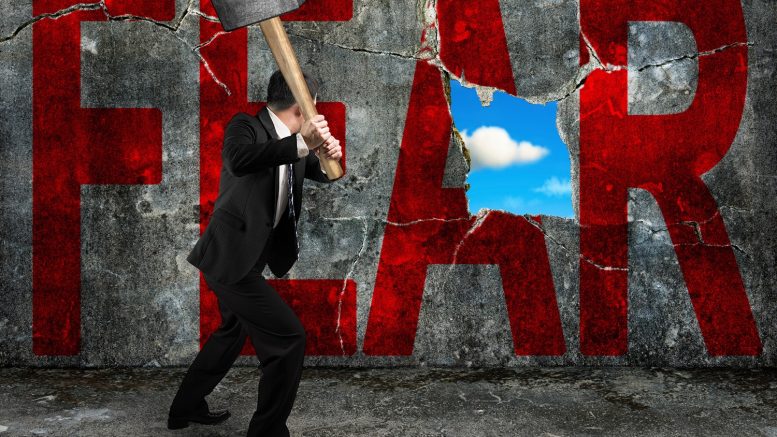Fear is an emotion everyone experiences in their lifetime. A perceived threat that activates fear can be physical, psychological, or emotional. It can also be real or imagined.
We often think of emotions like fear or anger as bad, but every emotion serves a purpose. Fear activates our survival instincts. It can motivate us to take action that will prevent us from harm. Some of us even enjoy being afraid, and we purposely watch scary movies or engage in high-risk adventures such as skydiving for the natural high of an adrenaline rush.
The impact of fear
If we live in constant fear, our physical health, memory, brain functioning, and mental health can suffer:
Physical Health
Chronic fear weakens our immune system, making us susceptible to viruses and bacterial infections. It can affect cardiovascular health and create gastrointestinal problems such as ulcers and irritable bowel syndrome. Living in fear for extended periods can lead to premature aging and early death.
Mental Health
Feeling constant perceived threats can lead to reduced productivity, fatigue and diagnoses such as depression, anxiety and post-traumatic stress disorder (PTSD).
Brain Function
The ability to regulate emotions, read non-verbal clues, reflect before responding and act ethically are all brain functions that can be disrupted. Since decision-making goes through the emotional center of our brain, chronic fear leads to poor decisions and inappropriate reactions.
Memory
According to the National Institute for Health[i], “Fear memory formation may induce changes in neurons within specific brain regions that affect the formation and extinction of future different memories.” This can make regulating fear more difficult.
Ways to minimize chronic fear
Thankfully, we can take many easy actions as often as necessary to minimize the effects of fear in our lives. Below is a partial list of specific actions to minimize the intensity of fear. Pick a couple of practices that appeal to you and are easy to repeat when needed.
- Be aware of your emotions for a few minutes. We can’t run from them, but when we face them, they lose their intensity.
- Address fear by talking about it, writing about it or merely thinking about it with curiosity. When we pay attention, we can ask ourselves questions like, “How is this emotion serving me?” or “What can this teach me?”
- Move your body. Dance, run, or walk to engage in a physical exertion that pushes you beyond your perceived limits.
- Take slow, deep breaths. These breaths signal to the brain that you are safe and diminish the intensity of the emotion.
- Turn off the news. Today’s news is designed to keep you watching. How do you feel when engaged in news media? If it elicits fear, limit the amount of time you watch or listen each day.
- Pay attention to any sensations in your body as you scroll and read posts on social media. Block or hide posts that cause you to feel fearful and schedule periodic breaks from your apps.
- Make time to interact with friends or loved ones.
- Create a gratitude list and write down what you are thankful for in your life. Keep the list handy so you can add to it.
- Simply reflect on what you are thankful for and notice the feeling of fear shift to gratitude.
- The brain does not know the difference between fake laughter and real laughter. Watch a laughter yoga video on YouTube if you need help stimulating laughter. You can also watch a favorite comedy or share funny stories.
- Reflect on times when you have felt strong, secure and courageous.
- Change your body posture or engage in physical movement by standing up and assuming a powerful pose for three minutes or taking a walk.
- Be kind to yourself. Engage in favorite activities that make you feel alive. What do you do that makes you completely lose track of time?
- Question your thoughts. Just because you think them doesn’t mean they are true.
- Reread a favorite book or watch a favorite comedy.
- Eat a healthy diet. Avoid sugar, which can weaken your immune system.
- Help others for increased feelings of well-being
- Meditate or pray.
- Imagine the worst. The fear will lessen the more you confront it.
- Work with a professional coach to help build physical and mental resiliency.
By engaging in the activities listed above, you can regulate your emotions, manage your energy and reduce stress.
[i] Fear memory formation can affect a different memory: fear conditioning affects the extinction, but not retrieval, of conditioned taste aversion (CTA) memory
Special Offer
Click here to schedule a complimentary *Stress and Well-Being Assessment and debrief or to “Connect with Purpose. *This Stress and Well-Being Assessment is not the free online version; this version is only available from HeartMath-certified providers.
 About the Author
About the Author
Stacey Bevill, PCC, BCC. MPM® is the owner and CEO of Golden Career Strategies. she has over 24 years of business and marketing experience and has certifications in coaching, entrepreneurship, and project management, resiliency, communication and more. Bevill is passionate about helping organizations improve trust, communication, mental fitness and belonging as part of employee engagement and inspiration. She supports individuals in transition and those interested in personal leadership and vision, resiliency, and wellness.
Stacey is a credentialed Professional Certified Coach (PCC) by the International Coach Federation (ICF), a Board Certified Coach from the Center for Credentialing and Education (CCE), and is certified by the internationally acclaimed Newfield Network Coaching Institute. Additional training includes Positive Intelligence, Conversational Intelligence Enhanced Practitioner, Inspired Leadership from Case Western Reserve University, and Coaching for Managers from the University of California, Davis. Stacey is also a HeartMath® Certified Coach, Trainer, and Stress & Well-Being Assessment Provider. She is a Flow Energy Balance Indicator (FEBI® ) Assessment Certified Coach (Leadership Patterns) and a Strong Interest Inventory® and MBTI® Certified Practitioner. She is also a credentialed Harrison Assessments® provider for both individuals and organizations.
She has received “value-added” training for her manufacturing clients: Lean Six Sigma Black Belt training/exam, Certified Local Change Agent, Master Project Manager®, ISO 9001:2015 Standard & Internal/Supplier Auditor, IATF 16949: 2016 – Understanding Standard and Auditing, Stacey is a graduate of Leadership South Carolina, Leadership Spartanburg, The Women’s Campaign School at Yale, The Spartanburg County Foundation’s Grass Roots Leadership Development Institute, and Furman Connections: Women Leaders of the Upstate. She is an active volunteer with One to One: Women Coaching Women as a coach lead and serves as one of four volunteer coaches in South Carolina for Stand Beside Them, and provides coaching worldwide for Non-Profit Executive Directors through CoachAid. And received the Rotary International District Service Above Self award in 2007. Stacey serves on the Board of Trustees for the University Center of Greenville and is a member of Women In Manufacturing (WiM), Georgia Automotive Manufacturing Association (GAMA) Society of Manufacturing Engineers (SME), National Career Development Association (NCDA) and the SC Association for Talent Development (ATD). Stacey is available for speaking engagements and panel discussions. She lives with her husband, Bobby Bevill (winner of the international David Debien Award for technical expertise and for training excellence in the HVAC industry), and their five beloved rescue dogs in Upstate South Carolina.


Be the first to comment on "20 Ways to Minimize Fear"